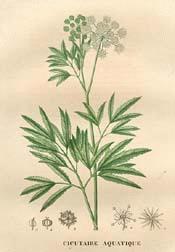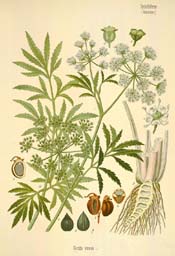
Botanical.com Home Page
Hemlock, WaterPOISON!Botanical: Cicuta virosa
---Synonym---Cowbane.
|

|
(Cicuta virosa) Click on graphic for larger image |
---Description---Water Hemlock is a perennial, with a short, thick, vertical, hollow rootstock, in shape somewhat like a parsnip, giving off whorls of slender, fibrous roots. The erect, very stout, hollow stem, rising 2 to 4 feet high or more, is smooth, branched and slightly furrowed. The lower leaves are large, 1 to 2 feet long and long-stalked; they are tripinnate, like the Hemlock. The upper leaves are divided into three leaflets, and each again into three (twice ternate). The flowers are pure white, arranged in rather large, longstalked umbels of 12 to 16 long, slender, curved rays. There is no general involucre.
The Water Hemlock may be distinguished from the true Hemlock as follows: (i) The pinnae of the leaves are larger and lanceshaped; (ii) the umbel of the flowers is denser and more compact; (iii) the stem is not spotted like the true Hemlock; (iv) the odour of the plant resembles that of smallage or parsley.
Both plants are poisonous; but while the root of the Water Hemlock is acrid and powerfully poisonous in its fresh state, though it loses its virulent qualities when dried, that of the true Hemlock possesses little or no active power.
The Water Hemlock produces tetanic convulsions, and is fatal to cattle. In April, 1857, two farmer's sons were found lying paralysed and speechless close to a ditch where they had been working. Assistance was soon rendered, but they shortly expired. A quantity of the Water Hemlock grew in the ditch, where they had been employed. A piece of the root was subsequently found with the marks of teeth in it, near to where the men lay, and another piece of the same root was discovered in the pocket of one of them.
---Constituents---A resinous body has been obtained from Cicuta virosa named Cicutoxin, an amorphous substance of acid reaction, of slight odour, but disagreeable taste; the dry root yields 3 to 5 per cent. The presence of a volatile alkaloid termed Cicutine has also been traced.
---Other Species---
AMERICAN COWBEAN
Botanical: Circuta maculata
Family: N.O. Umbelliferae
(POISON)
The American Cowbane is closely analogous to the European species, and also possesses very poisonous properties. In several instances, children have been fatally poisoned by eating its roots. It is said to be the most poisonous plant native to the United States.Although it has been recommended as a remedy in nervous and sick headaches, it is very rarely used.
No complete analysis of the plant has been published, but the alkaloid termed Cicutine, present in the European species, is said to exist in it. The seed is stated to contain an alkaloid identical with Coniine.
The root of this American variety is even more virulent than the English one.
See:
HEMLOCK
WATER DROPWORT
WILD CHERVIL - See CICELY, SWEET
WATER FENNEL
WATER PARSNIP
FOOL'S PARSLEY
[Top]
© Copyright Protected 1995-2025 Botanical.com
